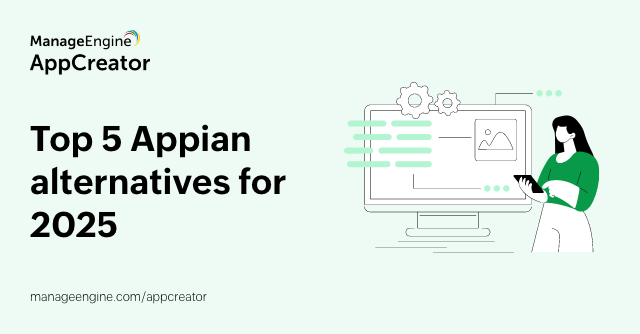Risk mitigation in IT using low-code empowered by AI
- Last Updated: November 29, 2024
- 63 Views
- 5 Min Read
These days, organizations are plagued by risks. According to a 2022 Forrester report, 41% of organizations experienced three or more critical risk events in the last 12 months. Having an effective risk mitigation strategy is therefore vital for survivability and viability.
As the advent of LLMs and generative AI have upended how organizations and entire industries function, a surprising but welcome application of AI is in risk mitigation.
Risk mitigation strategies
When it comes to risk mitigation strategies, off-the-shelf software solutions are dime a dozen. However, these solutions are too rigid, and customizing them is typically not possible.
A common approach is to mitigate IT risks by implementing a solution that's built from scratch. Though this method is custom and precise, it has a few major disadvantages, such as the time taken to implement custom solutions and the high cost associated with enlisting skilled specialists to enforce them.
There is an alternative that empowers stakeholders to architect and enforce risk mitigation strategies and measures all by themselves: low-code platforms. Low-code is a rapid application development approach that allows stakeholders to develop solutions by themselves with minimal coding. This is made possible by giving the solution architects a drag-and-drop, What You See Is What You Get (WYSIWYG) interface to build their risk mitigation solutions. Using low-code platforms saves valuable time while simultaneously empowering organizational stakeholders to enforce risk mitigation strategies all by themselves instead of relying on costly IT teams. Most of these platforms also provide integrations with AI, making them a one-stop solution shop for enforcing risk mitigation strategies. AI-powered low-code platforms empower organizations to identify vulnerabilities proactively, automate risk responses, and enforce risk mitigation before issues escalate or even materialize.
ManageEngine AppCreator is a powerful low-code platform. Its drag-and-drop app-building interface allows for the rapid deployment of risk mitigation solutions, and its AI capabilities—such as automatic, context-based application development and custom low-code generation—boost its risk mitigation potential.
Contemporary IT risks and how to mitigate them
Cyberattacks have long been an IT risk. But in the modern era, risks have expanded to include a wide variety of possibilities.
Let's take a look at the top three risk categories that are prevalent in the industry today and explore how to leverage the AI-powered capabilities of low-code platforms to tackle them.
Risk 1: Human error
The manual component of IT systems is a leading cause of risk. Overlooked security measures by human stakeholders open a plethora of vulnerabilities that malicious entities are quick to exploit.
Human errors can crop up during routine operations, responses to incidents, or critical decision-making situations.
Types of human errors in IT and how to mitigate them using low-code
Human error | Description | How you can leverage a low-code platform to tackle this |
Misuse of applications, tools, and systems | A misuse of resources due to a lack of training or subject matter knowledge. | Role-based access controls: Provide access to features only for those who have completed the necessary training. |
Communication gaps and failures | Errors in IT processes due to lack of proper communication or delays. |
|
Oversight by stakeholders causing missed backups and botched updates
|
Errors due to human oversight and negligence.
| AI-powered workflows: Automatically schedule backups and implement updates flawlessly, at a predefined date and time. |
Risk 2: System downtime
According to a report by Gartner®, the average cost incurred due to IT downtime is $5,600 per minute. Some common types of downtime are partial downtime, planned downtime, and unplanned downtime. While the occasional downtime for maintenance and security patching requirements is unavoidable, prolonged downtime can cause significant losses to all stakeholders.
System downtime problems in IT and how to mitigate them using low-code
System downtime problem | Description | How you can leverage a low-code platform to tackle this |
Configuration errors | Misconfigurations or wrong system configurations leading to system outages. |
|
Failures caused due to tertiary dependencies | Downtime caused when a third-party service or an API faces an issue. |
|
Overloading | Systems crash due to being stretched beyond their permissible capacity. | Interactive dashboards with instant alerting capabilities: Low-code platforms offer usage trend analysis through dashboards, which can signal notifications to stakeholders when high loads occur, thereby providing the possibility of reducing their load, to preempt crashes. |
Risk 3: Compliance failures
The need to adhere seamlessly to industry standards is more vital today than ever. Noncompliance can cause hefty fines by governments and regulatory bodies, not to mention adverse reputational and operational repercussions.
In the following table, we will take a look at the major compliance risks that abound today, and how to leverage an AI-powered low-code application platform's capabilities to mitigate them.
Compliance risks and how to mitigate them using low-code
Compliance risk | Description | How you can leverage a low-code platform to tackle this |
Regulatory noncompliance | Noncompliance with industry regulations resulting in fines, tariffs, and penalties by regulatory bodies. |
|
Loopholes in data privacy | Non-implementation of stringent data protection protocols, resulting in data breaches, loss of confidential information, and financial and reputational damage. |
|
Audit trail risks | Inefficient logging and tracking of activities that result in difficulties in keeping a hold over organizational activities, such as data access. |
|
Low-code powered by AI: A powerful synergy
AI is growing by leaps and bounds. By harnessing these advancements, low-code platforms can reinvent themselves as technological powerhouse tools to avoid risks. The deep customizability of low-code platforms like AppCreator, combined with the agility and granularity provided by the intrinsic capabilities of AI, make this synergy a powerful combo. Check out the low-code platform, AppCreator, today and see how you can leverage its AI-powered capabilities to mitigate and deter risks.




